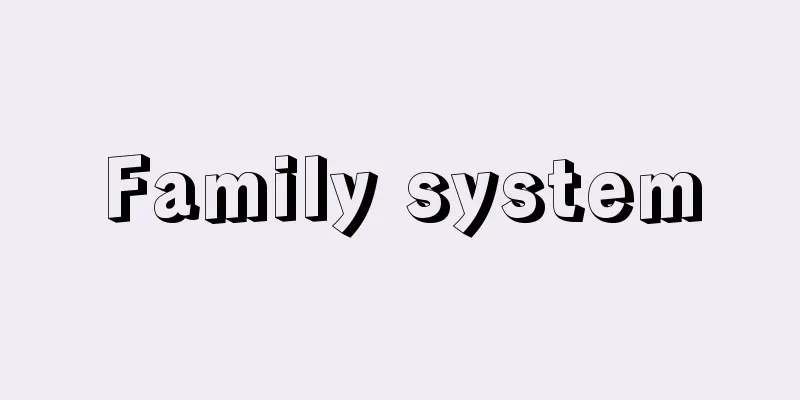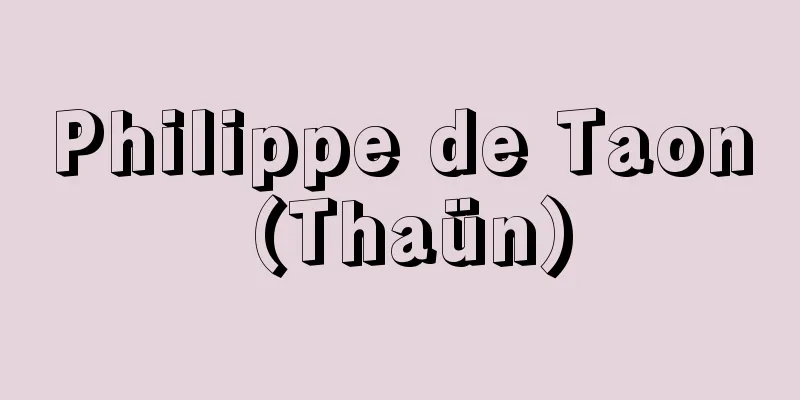Family system

|
It refers to the totality of laws, customs, morals, and other norms regarding the structure and function of the family. In the narrow sense, it meant the legal system of the "ie" (family) stipulated by the Meiji Civil Code. Of course, the "family system" in this sense was dissolved with the revision of the Civil Code (1947) after World War II. However, the customary ie system had been seen as a family system in Japanese society for a long time since the early modern period, even before the Meiji Civil Code, and even after the revision of the Civil Code, although it had become weaker. After the abolition of the "ie" system in the Civil Code, especially after the period of high economic growth in the 1960s, the modern Japanese family system shifted to one that is centered on small families, mainly nuclear families. The traditional "family system" in the narrow sense is just one form of the wide variety of family systems that societies with different cultures have shown in various eras. Family systems that differ depending on ethnicity and era can be classified in various ways depending on the perspective. Although there are rare exceptional societies such as the Heyer Indians (a hunter-gatherer tribe living in the cold regions of northwestern Canada) where it is reported that fatherlessness is the norm, in general, human beings live together for a long period of time, with a married couple and their children, either born or adopted, until the children reach adulthood and become independent. When the social norms of a nation, a large or small local community, or a religious organization attempt to guarantee a form of order that is deemed necessary for the stability of social life through laws, customs, and morals, a system is established that governs the family life that should be lived in that society. Looking at existing family systems, first from the perspective of marriage systems, it is determined whether a society will tolerate or prohibit things such as monogamy (monogamy) or polygamy (polygamy or polyandry), exogamous marriage, where a marriage partner is sought outside the community, or intraogamous marriage, where a marriage partner is sought outside the community. There are various types of authority structures within the family, such as patriarchy, matriarchy, patriarchy, and marital partnership, and there are systems for inheriting family property, such as single-child inheritance and equal shares. Regarding cohabitation and support, different systems have been established in each era and society, such as patrilineal extended family, matrilineal extended family, lineage family, and nuclear family. In China and Korea, married couples have had separate surnames since ancient times, but this has a different meaning from the proposed amendment to the Civil Code (1996) to allow married couples to have separate surnames. [Takashi Nakano] Japanese Family SystemThe legal "family" system in the Meiji Civil Code was limited to a certain period in modern Japan, and was an organization consisting of all relatives of the head of the household who belonged to the same family register. It did not necessarily correspond to the family group living together in reality. In the current Civil Code, a family register unit is organized by the free agreement of a man and woman who have reached adulthood, based on the dignity of the individual and the equality of the sexes. This is a big change from the past, when a new couple was registered in the family register by marrying into either of their parents' family registers, or by marrying into the family register (by marrying into the family register or by marrying into the family register as a son-in-law) and then splitting off the family. However, the current family register unit does not necessarily reflect the actual state of family life. A flexible system has emerged in which a child couple initially lived separately from their parents, but later chose to live together with their elderly parents. [Takashi Nakano] "Research on the Legal History of Houses and Villages" by Kamiya Chikara (1976, Ochanomizu Shobo)" ▽ "Research on Merchant Family Associations" by Nakano Taku (1978, Miraisha)" ▽ "Kyoto in 1910 - The Diary of a Young Merchant's Wife" edited by Nakano Taku (1981, Shinyosha)" ▽ "Hara Hiroko's Hair Indians and Their World" (1989, Heibonsha)" ▽ "The Japanese Family System and Tenant System" (included in Ariga Kizaemon Collected Works I and II edited by Nakano Taku et al., 2000, Miraisha) [Reference items] | | |Source: Shogakukan Encyclopedia Nipponica About Encyclopedia Nipponica Information | Legend |
|
家族の構成や機能についての法律、慣習、道徳などの諸規範の総体をいう。狭義には明治の民法によって規定された法制上の「家(いえ)」に関する制度を意味した。もとより第二次世界大戦後の民法改正(1947)で、この意味での「家族制度」は解消した。しかし、慣習としての家制度は明治の民法以前から、近世以来長期にわたって日本の社会における家族の制度として、民法改正後さえ希薄化しつつもなおみられた。現代日本の家族制度は、民法上の「家」制度廃止後、とくに1960年代の高度経済成長期を経て核家族を中心とする小家族を本位とするものに移行した。従来の、狭義の「家族制度」は、異なる文化をもつ社会がさまざまな時代に示した多種多様な家族制度の一つの形にすぎない。民族により、また時代により異なる家族制度は、観点によって多様な分類が可能である。 父親のいないのが常態と報告されているヘヤー・インディアン(カナダ北西部の寒冷地に住む狩猟民)のような特例的社会がまれにあるとしても、人類は、一般的に婚姻による夫婦がやがてはそのもとに出生あるいは養取による子と、その成人独立までは同居し、家族生活を長期にわたって営むことを常態とする。国家や大小の地域社会ないしは宗教団体における社会的規範が、社会生活の安定に必要とみた形の秩序を、法律や慣習や道徳によって保障しようとするとき、その社会で営まれるべき家族生活の準拠すべき制度が成立する。現存する家族の制度を、まず婚姻に関する制度からみれば、単婚(一夫一妻婚)か複婚(一夫多妻か一妻多夫)か、婚姻の相手を一定共同社会の範囲外に求める族外婚か、その逆の族内婚かなどというようなことが、その社会で許容され、あるいは禁止されるかが婚姻制度として決まっている。家族内の権威構造についても父権制、母権制、家父長制、夫婦パートナーシップ制などがあり、家産相続については一子相続制や均分相続制がある。同居や扶養のあり方についても、父系拡大家族、母系拡大家族、系譜家族、核家族などの異なる制度が、その時代その社会での家族制度となっている。中国や韓国などでは古来夫婦別姓であるが、日本の夫婦別姓への民法改正案(1996)とは意味が異なる。 [中野 卓] 日本の家族制度明治の民法における法制上の「家」制度は、日本の近代における一時期に限られたものであり、同一戸籍に属する戸主の親族関係者すべてにより構成される団体であった。それは現実に共同生活を営む家族集団とはかならずしも一致しなかった。現在の民法では、個人の尊厳と両性の平等に基づき、成年に達した男女の自由な合意により一戸籍単位が編成される。かつて、新夫婦はその双方の両親いずれかの側の戸籍に婚入し、あるいは婚入(婚入か婿入)したうえで分家するという形で戸籍上登録されたのとは大きな変化である。しかし、現行戸籍単位もまた、かならずしも実際の家族生活の実態をそのまま示すものではない。子夫婦が親夫婦と当初は別居した家族単位も、のちには双系老親と選択的に同居する場合を含む柔軟な形の制度が生じえた。 [中野 卓] 『神谷力著『家と村の法史研究』(1976・御茶の水書房)』▽『中野卓著『商家同族団の研究』(1978・未来社)』▽『中野卓編『明治43年京都――ある商家の若妻の日記』(1981・新曜社)』▽『原ひろ子著『ヘヤー・インディアンとその世界』(1989・平凡社)』▽『『日本家族制度と小作制度』(中野卓他編『有賀喜左衞門著作集Ⅰ・Ⅱ』所収・2000・未来社)』 [参照項目] | | |出典 小学館 日本大百科全書(ニッポニカ)日本大百科全書(ニッポニカ)について 情報 | 凡例 |
<<: Family inheritance - Kazokuseshuzaisan (English spelling) Familienfideikommisse [Germany]
>>: Family Policy - Family Production
Recommend
Murata Seifu
Year of death: May 26, 1855 (July 9, 1855) Year of...
Cohen, Stanley
[Born] November 17, 1922. New York, New York. Bioc...
Alalia chinensis (English spelling) Alaliachinensis
…[Nitta Aya]. . . *Some of the terminology that m...
Edo Koboku - Edo Koboku
…During the Edo period, feudal lords and wealthy ...
"Eawase Taikouki" - Eawase Taikouki
...13 sections. Also called Ego Taikoki. A collab...
chlamys
...On special occasions, such as festivals, a lon...
Inspiratory neuron
…A large number of respiratory neurons are distri...
Elohistic Source
…Both are considered to have been produced as off...
Gongsun Yuan (English spelling)
[raw]? [Death] Jingchu 2 (238) King of Yan during ...
Euplectella imperialis (English spelling)
...Seawater enters through the eyes in the body w...
Ultrasonic testing - Ultrasonic testing
This is a non-destructive inspection that uses ult...
Enhanced Radiation Warhead
...A nuclear weapon that increases the proportion...
Ohayashi - Ohayashi
...A term in Japanese music. The word comes from ...
Kokichi Mikimoto
Year of death: September 21, 1954 Year of birth: J...
Izuba - Izuba
...These two classes sometimes shared common inte...




![Vorogeses [I] - Vorogeses](/upload/images/67cf839d212e6.webp)




